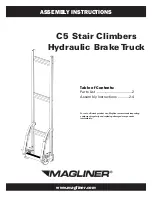
2.
Turn the ignition switch to the start position.
Without touching the throttle pedal, start the en-
gine.
NOTE: Some starters are equipped with op-
tional overcrank protection. If overcranking oc-
curs, a thermostat breaks the electrical circuit to
the starter motor until the motor has cooled.
3.
Idle the engine for one to three minutes at 600 to
850 rpm before operating the engine under load.
4.
Check the oil pressure gauge for any drop in lu-
bricating oil pressure or mechanical malfunction
in the lubricating oil system. Minimum oil pres-
sure at idle is 7 psi (50 kPa).
CAUTION
Do not rev the engine if the oil pressure gauge
indicates no oil pressure. Shut down the engine
if no oil pressure appears within approximately
ten seconds. Check to determine the cause of the
problem. Operating the engine with no oil pres-
sure will damage the engine.
Cold-Weather Starting
Modern electronic engines do not normally require
special starting aids. At low temperatures, oil pan
heaters or water jacket heaters are sometimes used
to assist in starting.
WARNING
If using a cold-weather-start system, be sure to
follow the manufacturer’s instructions regarding
its use, handling, and storage. Many starting flu-
ids are in capsules or pressure cans, and im-
proper usage can be dangerous.
Do not attempt to use any type of vapor-
compound start system near heat or open flame.
Engine damage due to an explosion or fire in the
intake manifold could result.
Do not breathe the ether fumes; doing so could
result in personal injury.
Caterpillar
Turn the ignition switch to the on position (
Fig. 7.6
).
If the engine doesn’t start after 30 seconds of crank-
ing, turn the key to the off position and wait two min-
utes; then repeat the starting procedure.
If the coolant temperature is less than 64°F (18°C),
the engine will start up in the cold-start strategy. This
reduces the amount of fuel available to the injectors,
advances the timing, and controls white smoke emis-
sions. The engine remains in the cold-start strategy
until the coolant temperature rises above 64°F
(18°C), or until it has been running for 12 minutes.
IMPORTANT: Do not move the vehicle when it
is in the cold-start strategy. Power will be notice-
ably reduced.
After a cold engine start of less than 64°F (18°C),
Caterpillar electronic engines automatically idle at
800 rpm (for C–10 and C–12 engines), or 600 rpm
(for 3406E, C–15, and C–16 engines). These elec-
tronic engine systems will adjust the idle speed to
700 to 750 rpm when the engine is warm enough to
drive the vehicle.
Cummins
The cold-start system approved for use on Cummins
engines has been based upon starting aid capabili-
ties to –25°F (–32°C). For more information, see the
Cummins
Operation and Maintenance Manual
.
Turn the ignition switch to the on position (
Fig. 7.6
).
If the engine doesn’t start after 30 seconds of crank-
ing, turn the key to the off position and wait two min-
utes; then repeat the starting procedure.
Run the engine slightly above idle until oil pressure
shows on the gauge. If oil pressure doesn’t show on
the gauge within 30 seconds of starting, turn the key
to the off position and wait one minute; then repeat
the starting procedure.
DDE S60
The engine may require the use of a cold-weather
starting aid if the outside temperature falls below
40°F (4°C).
Turn the ignition switch to the on position and start
the engine.
If the engine doesn’t start after 30 seconds of crank-
ing, turn the key to the off position and wait two min-
utes; then repeat the starting procedure.
Engines and Clutches
7.9










































